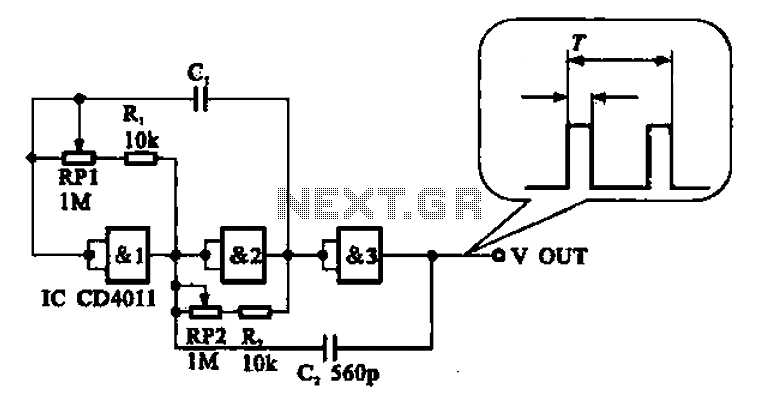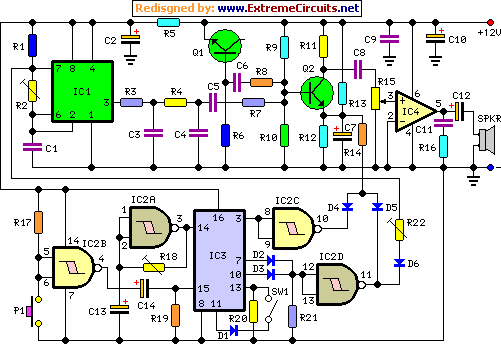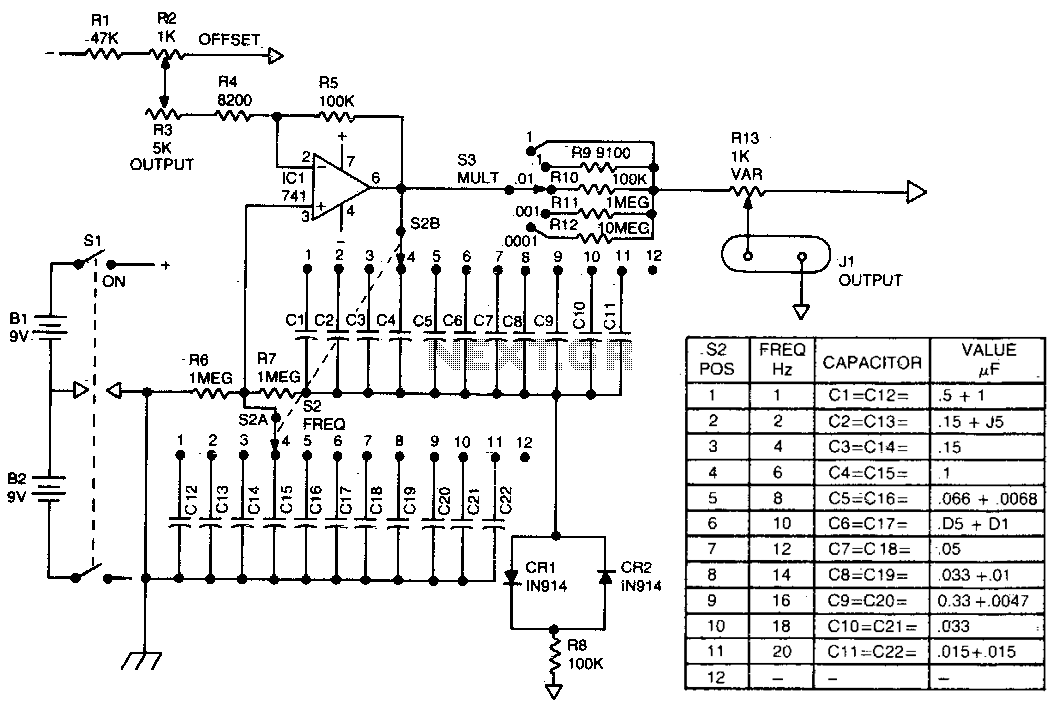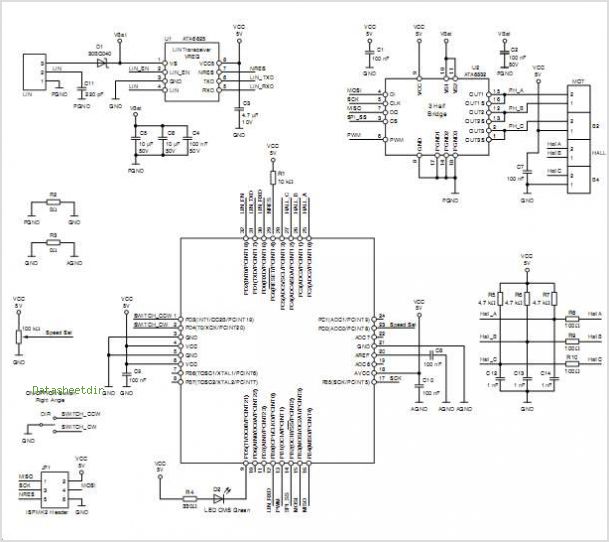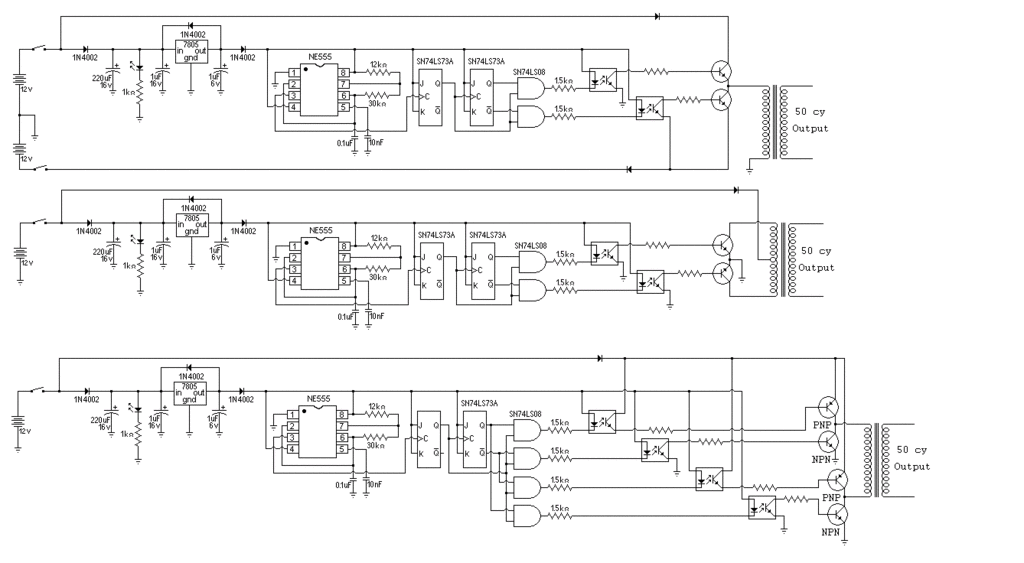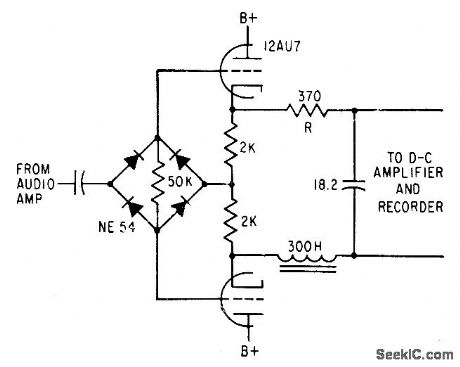
Baud Rate Generator
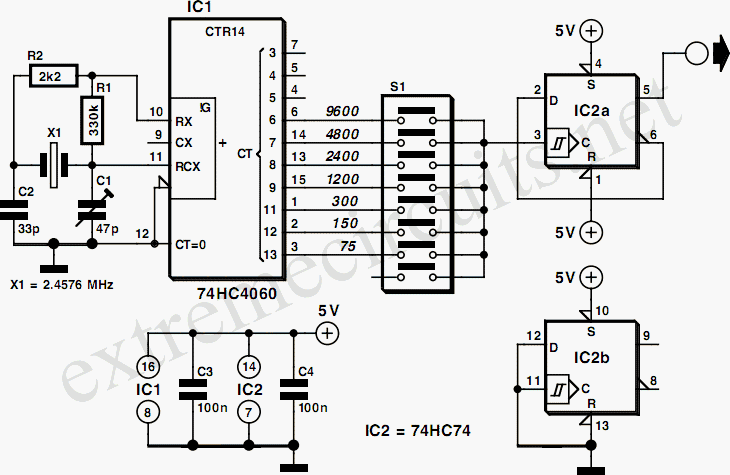
This article discusses the use of an RC oscillator as a baud rate generator. When calibrated accurately within a few percent using a frequency meter, the circuit performs effectively. However, it may experience some drift over time. To address this, a small crystal-controlled oscillator is presented. Starting with a crystal frequency of 2.45765 MHz and dividing it by multiples of 2 allows for the generation of standard baud rates such as 9600, 4800, 2400, 600, 300, 150, and 75. Notably, the 1200 baud rate is absent due to the lack of a Q10 output from the 4060 divider. For those requiring 1200 baud, a divide-by-two stage is added after the 4060 using a 74HC74 flip-flop, resulting in a baud rate series that omits 600 baud instead. A trimmer capacitor can be used for calibration, with a typical value of 33 pF providing adequate accuracy. The circuit operates with very low current consumption, approximately 1mA, thanks to the utilization of CMOS components.
The circuit design incorporates an RC oscillator that generates a stable frequency, which is then divided to produce various baud rates suitable for serial communication applications. The initial frequency of 2.45765 MHz is selected due to its compatibility with standard communication protocols. The 4060 frequency divider is employed to achieve the desired baud rates through binary division. Each output of the 4060 corresponds to a specific baud rate, but due to the absence of a Q10 output, the 1200 baud rate is not directly available.
To enable the 1200 baud rate, a 74HC74 flip-flop is integrated into the circuit as a divide-by-two stage. This addition effectively allows the generation of 1200 baud while sacrificing the 600 baud rate output. The flip-flop is triggered by the output signal from the 4060, ensuring that the timing remains coherent with the other baud rates produced.
For precise calibration, a trimmer capacitor is included in the design. The typical value of 33 pF is selected to ensure that the oscillator can be fine-tuned for optimal performance, allowing the user to adjust the frequency as needed to meet specific application requirements. The use of CMOS technology in the circuit design contributes to its low power consumption, making it suitable for battery-operated devices or low-power applications.
Overall, this circuit provides a versatile solution for generating multiple baud rates while maintaining low power consumption and offering the flexibility for calibration.In this article, an RC oscillator is used as a baud rate generator. If you can calibrate the frequency of such a circuit sufficiently accurately (within a few percent) using a frequency meter, it will work very well. However, it may well drift a bit after some time, and then . Consequently, here we present a small crystal-controlled oscillator. If you start with a crystal frequency of 2. 45765 MHz and divide it by multiples of 2, you can very nicely obtain the well-known baud rates of 9600, 4800, 2400, 600, 300, 150 and 75. If you look closely at this series, you will see that 1200 baud is missing, since divider in the 4060 has no Q10 output!
If you do not need 1200 baud, this is not a problem. However, seeing that 1200 baud is used in practice more often than 600 baud, we have put a divide-by-two stage in the circuit after the 4060, in the form of a 74HC74‚ip-‚op. This yields a similar series of baud rates, in which 600 baud is missing. The trimmer is for the calibration purists; a 33 pF capacitor will usually provide sufficient accuracy.
The current consumption of this circuit is very low (around 1mA), thanks to the use of CMOS components. 🔗 External reference
The circuit design incorporates an RC oscillator that generates a stable frequency, which is then divided to produce various baud rates suitable for serial communication applications. The initial frequency of 2.45765 MHz is selected due to its compatibility with standard communication protocols. The 4060 frequency divider is employed to achieve the desired baud rates through binary division. Each output of the 4060 corresponds to a specific baud rate, but due to the absence of a Q10 output, the 1200 baud rate is not directly available.
To enable the 1200 baud rate, a 74HC74 flip-flop is integrated into the circuit as a divide-by-two stage. This addition effectively allows the generation of 1200 baud while sacrificing the 600 baud rate output. The flip-flop is triggered by the output signal from the 4060, ensuring that the timing remains coherent with the other baud rates produced.
For precise calibration, a trimmer capacitor is included in the design. The typical value of 33 pF is selected to ensure that the oscillator can be fine-tuned for optimal performance, allowing the user to adjust the frequency as needed to meet specific application requirements. The use of CMOS technology in the circuit design contributes to its low power consumption, making it suitable for battery-operated devices or low-power applications.
Overall, this circuit provides a versatile solution for generating multiple baud rates while maintaining low power consumption and offering the flexibility for calibration.In this article, an RC oscillator is used as a baud rate generator. If you can calibrate the frequency of such a circuit sufficiently accurately (within a few percent) using a frequency meter, it will work very well. However, it may well drift a bit after some time, and then . Consequently, here we present a small crystal-controlled oscillator. If you start with a crystal frequency of 2. 45765 MHz and divide it by multiples of 2, you can very nicely obtain the well-known baud rates of 9600, 4800, 2400, 600, 300, 150 and 75. If you look closely at this series, you will see that 1200 baud is missing, since divider in the 4060 has no Q10 output!
If you do not need 1200 baud, this is not a problem. However, seeing that 1200 baud is used in practice more often than 600 baud, we have put a divide-by-two stage in the circuit after the 4060, in the form of a 74HC74‚ip-‚op. This yields a similar series of baud rates, in which 600 baud is missing. The trimmer is for the calibration purists; a 33 pF capacitor will usually provide sufficient accuracy.
The current consumption of this circuit is very low (around 1mA), thanks to the use of CMOS components. 🔗 External reference
